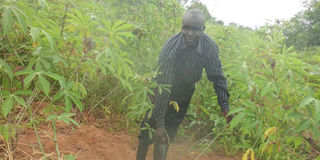Scientists intensify crop breeding

Cassava farmer from Alivu village, Rhino Camp in Arua district on his farm comprising Naro cas1 and 2 cassava varieties Photo Lominda Afedraru.
What you need to know:
- Agricultural scientists are determined to breed more high yielding crops to address most of the farmer’s challenges such as disease, low yields and pests, writes Lominda Afedraru
Ugandan scientists have intensified efforts to breed key crops using conventional and biotechnology mechanisms in a bid for farmers to grow high yielding crops which are also resistant to pests and diseases.
Scientists from National Agricultural Research Organisation (Naro) have been breeding hybrid varieties of crops such as maize, cassava, rice, sweet potato, banana among others which farmers are growing countrywide.
The products of these crops have not been released to farmers because of lack of legal framework which is a requirement in regulating the same.
The Biotechnology and Biosafety bill which was drafted by government in 2012 is still before parliament for debate.
But farmers in West Nile, mainly growing cassava, are embracing hybrid cassava varieties because of their commercial value and tolerance to cassava brown streak virus.
They attribute this success to scientists at Abi Zonal Agricultural Research and Development Institute (Abi ZARDI) who access the new varieties and make sure farmers get them.
The director of the institute,Dr Sadik Kassim explains that since the people of West Nile rely on cassava as their staple food, it is the mandate of the institute to ensure farmers are given the right variety bred using new emerging technologies for them to realize good yield.
“We have tested cassava varieties like NASE14, 19 and Naro Cas1 and Naro Cas2, which are high yielding, aromatic, sweet in taste, can withstand pests and diseases and are rich in food matter,” he noted.
Agronomist
Sisto Moja is an agronomist majoring in cassava at Abi ZARDI. He says for farmers to realise good yield, they must start with land preparation such as clearing all grass, and tree trunks.
Farmers are advised to choose disease free planting material.
Select cuttings from the middle stem portions, 30 centimetres long with an average of 9-12 nodes. Cut setts using a handsaw or clean, sharp cutlass sterilised in a one per cent sodium hypochlorite solution and if possible dip in a fungicide solution for 10-15 minutes and allow it to drain off before planting.
The stalk must be planted 50 (deep) by 90 (width) centimetres and use a pre- emergent herbicide to control weeds for the first three months of growth.
Hand-weeding using hoes is normally recommended after three months. The enlarged crop canopy should also limit weed growth in the same period.
Diseases
The major pests and diseases of cassava are thrips and mites which can be controlled using a recommended miticide and insect growth regulators. These pests are prevalent during dry periods and decreases as rainfall increases.
Cassava shoot fly is another and systemic insecticides should be used only during heavy infestations.
Others diseases include cassava bacterial blight, rust and super elongation disease and the chinch bugs where crotalaria can be used as a trap crop for this bug as well as crop rotation practices which break the life cycle of the bug.
These pests and diseases are the biggest constraints to cassava production in Uganda. Statistics indicate that they can cause losses of up to $24.2m (Shs81.7b) annually.
When harvested and fresh from the ground, the new cassava varieties can yield 14 to 55 tons per hectare.
“Growing cassava can be profitable if the farmer follows advise of the agronomist,” said Drasiku.
Farmer’s account
Abdallah Drasiku is a farmer growing hybrid cassava varieties Nase19, Naro Cas1 and 2 on an 80 acre piece of land in Olali village, Ogoko County, Arua District.
He began growing cassava in 2012 where he planted TME14 on 12 acres of land but it succumbed to CBSV leading to poor harvest.
The following year he planted Naro Cas varieties on a 20 acre land and he supplied over 800 bags of cassava stalk to Naads each bag costing Shs25, 000 – Shs27, 000 in the first season.
He obtained about 200 bags of milled cassava which he sold at 50,000 per bag. In 2015 he planted Nase14 on 16 acres of land and harvested 1,400 bags of cassava stalk which he sold to operation wealth creation each bag costing Shs50, 000.


